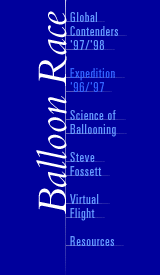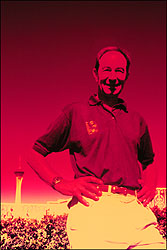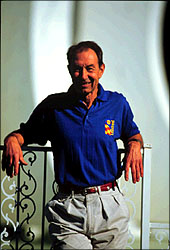 |
 |
Interview with
|
|
Ackroyd via RealAudio: 14.4 | 28.8 | ISDN Get RealAudio software |
ACKROYD: A De Rozier system is a mixture between a gas balloon and a
hot air balloon. In other words on a long flight, every day in the heat of the
sun, the gas expands, becomes comparatively lighter, and the balloon wants to
go up. Every night, the gas contracts, becomes comparatively more dense and
the balloon wants to go down. And the way to iron out these ups and downs is
to warm the air beneath the helium to gain extra lift at night. And that is
basically the De Rozier system. It's a very old system, used by De Rozier, way
back in the last century and, unfortunately, he used it with hydrogen, which
was all he had, and it was an explosive mix and poor De Rozier became, I think,
the first man to lose his life in a balloon. But we use helium, which is a
nice, inert, safe gas. NOVA: Is it a double balloon system, then? ACKROYD: It is a compound balloon system. A double balloon system would, perhaps apply more to the Earthwinds type of system, which had a helium balloon on top and an air ballast balloon underneath. What we've got is a helium balloon in a bottle over the top of a hot air cone and the hot air cone heats the helium, which gives it extra lift at the cost of fuel. NOVA: And what do you mean, "at the cost of fuel"? ACKROYD: Well, it means that to fly a De Rozier balloon, you have to carry a penalty and that penalty is propane in our case, which heats the air, which heats the helium, which keeps the balloon up. NOVA: Which means that you will have a heavier payload? ACKROYD: We're carrying a higher payload, yes. We're carrying fuel. And that is what this test program we're now entering into is very much about. How much fuel will we need to carry? How fast will we be burning it? Will we have fuel left over that we can use for ballast? Will we burn a bit out of each tank or will be burn a complete tank empty and drop it? So that will give us the formula on how best to use our fuel. And, in fact, we may be able to learn that we can use fuel for ballast as well as lift. So it can work a double bonus. NOVA: Do you think this system has a better chance of success than Fossett's solo system? I understand he's using a De Rozier and there are obviously different variables because he's flying solo and he's flying at a lower altitude. From your perspective, which De Rozier has a better chance? |
|
Ackroyd via RealAudio: 14.4 | 28.8 | ISDN |
ACKROYD: Well, really, the three major systems that are currently being
investigated—in fact, there's four—the De Rozier is one and this seems
the middle of the road system. It worked well on the Atlantic balloon race.
It seems at the moment to be the fashionable solution, though there are other
things around. One can use a super pressure balloon, which keeps a constant
pressure altitude, but if you burst that balloon, you're in big trouble. And
we saw an actual super pressure envelope burst with the Earthwinds project,
but, fortunately, that was a ballast balloon and not the lift balloon. For a
lift balloon to burst is a serious problem. So I just hate the situation. So
we're going with De Rozier, the same as Steve Fossett. The big difference between ours and Steve's is that he's going to fly a low altitude attempt and we'll fly a higher jet stream altitude. There are three altitudes which one could attempt this 'round the world. There's the very, very high Odyssey-type balloon, which goes way up to 100,000 feet—fantastic height, and will then fly with jet streams or upper altitude streams going in the opposite direction from jet stream flights, which go from west to east. They would go in the opposite direction and they would slowly descend, hopefully circling the world as they go. This is a very extreme, innovative kind of attempt and to come back to ours, it's the middle of the road. We will try to fly with the jet stream. We've done it before, we've got a lot of experience in it and it seems to me that that is the rapid fast way around the world. Above the air in the fastest streams with the technology we already know. Fossett's is a low-altitude attempt and so he will be flying a simpler system and simple is always good. He will have to use oxygen a lot more so it will be uncomfortable and he will have to combat the weather, rather than fly above it. And I think that will be very adventurous. I think he'll have a lot of hard weather situations to get 'round, but he's a very determined, accomplished, capable man and I wouldn't ever underestimate his ability to go a long way at low altitude. NOVA: What do you know of the fourth group? ACKROYD: At the moment, there are no super pressure attempts that I know of underway, really. Julian Knott was proposing one some time ago, and in fact, he made a very long distance flight in Australia with one, which was a pumpkin-shaped super pressure balloon. But it seems to have died a bit of a natural death, maybe because of the high risk involved. NOVA: What about the team that wants to launch out of the Swiss Alps? ACKROYD: That is the Piccard attempt, sponsored by the Swiss watch maker, Breitling, and that is another De Rozier balloon and, as far as I know, it's similar in concept to Steve Fossett's. NOVA: Our mission, as you know, is science and technology. What kinds of technical and educational background does one need to do what you do? |
|
Ackroyd via RealAudio: 14.4 | 28.8 | ISDN |
ACKROYD: Well, I think you have to understand several fronts. One is
the basic physics of ballooning or aerostatics, which is based on things like
Boyles' law and expansion of gases and change of gas with temperature and
pressure and also, of course, there was—apart from the physics of it—there is the technical aspect of building a balloon itself which is materials
testing, welding, what are the best materials, what are the solar properties of
retaining and transmitting heat... And on top of that, then, there is the general engineering for building a capsule, which is basically firmer dynamics, we're going to run engines, we're going to gain heat, we're going to pressurize the capsule, it comes into survival systems, life support systems, floatation systems, and keeping the pilots alive, keeping the burners and engines—pressurization engines running, and, of course, there's a huge natural geographic element here because we will be really fighting the elements. Mother Nature—one would need a good understanding of the geography of the world, which I think would be interesting to people. Following this flight, we'll be flying across all sorts of countries. We're flying in the air. The air is an interesting medium in its own right. It changes temperature, it changes pressure, it's subject to weather, it's subject to moving air streams, which, once again, I think is a very educational element and we learn an enormous amount, just being associated with it. We're learning about the world we live in. NOVA: You've been involved in another global ballooning attempt, of course, and Richard and Per's past record-breaking flights. What do you see as the largest limiting factor—the biggest obstacle—to these flights?  ACKROYD: Well, really, I think you can't miss the biggest concern. The
concerns of all these projects are man, machine and the elements. You have to
have the crew right, you have to have the machine right, you also have to have
the elements right as well. Because without all three being right, both in
concept, and in detail, you won't succeed. And without the right people and
the right flying machine, you cannot succeed. But even if you have the right
people and the right flying machine, you may not succeed if the elements stack
against you. So I think you can't ignore 'em. ACKROYD: Well, really, I think you can't miss the biggest concern. The
concerns of all these projects are man, machine and the elements. You have to
have the crew right, you have to have the machine right, you also have to have
the elements right as well. Because without all three being right, both in
concept, and in detail, you won't succeed. And without the right people and
the right flying machine, you cannot succeed. But even if you have the right
people and the right flying machine, you may not succeed if the elements stack
against you. So I think you can't ignore 'em. NOVA: With this project, as with all others, when you're working on designing a system from scratch, do you begin with drawings or do you start with a system that already exists? Where do you begin? ACKROYD: Well, I think, really, as an engineer, one is not really an inventor. And I think we haven't invented a system here. All of it is really development of previous ideas. It's very difficult to come up with something that hasn't been thought of before. But new materials are developed and new knowledge is developed, but it is based on old, well proven ideas and I think this particular attempt is very much the development of existing technology, rather than new technology. NOVA: I'm sure you're finding new things in the existing technology. For example, an around the world balloon flight has never been done before. We're starting from the basic fact that no manned balloon has ever flown in the jet stream for more than—what is it—five days? And so, to go beyond that, there are some unknown variables. ACKROYD: There certainly are, but—I mean, very much what we're doing is building upon the foundations we have and taking them further. And with that step, a lot of work with this one has gone into the balloon because the balloon itself is the key to extending the duration. The capsule is very much the same technology, but just a little bigger and a little better equipped to make the longer flight more bearable. But really, the balloon technology is what we've been concentrating on for two reasons. One is that we will still only be able to carry a limited amount of fuel so we have to be more efficient with our fuel burn to make it 'round the world. And I think Leon (Eversfield, the Special Projects Engineer for Virgin Global Challenger) will tell you about the efforts that have gone into this balloon to make it more fuel efficient to give it that range to give it the safety, durability and range that we're looking for. NOVA: How do you calculate the amount of lift needed for a system like this? ACKROYD: Well, basically, the system is very, very simple but the refinement is where the trick lies, as always. And simply, one cubic meter of helium, very approximately, lifts one kilogram of weight. So if we can work out how much we have to lift, the weight of the capsule, the fuel, the people, the ballast, the food, the water, and the balloon envelope, itself, then we can work out how big the balloon has to be to lift this load. And our load is approximately ten tons and we have approximately just over a million cubic feet of balloon. And Leon, I'm sure, will explain in greater detail the niceties of this, which, as we've said, depend on the temperature and the flying environment, a bit. And we always have an ability to expand because, as the balloon goes up, so, the air around it gets thinner and the balloon will expand. So we don't take off with a full balloon. If we are going up into an atmosphere which is only a third as dense as down here on earth, we will only fill the balloon one third. Because as it goes up, the air will get thinner and fill the other two thirds of the balloon. So the balloon, in actual fact changes in its shape as it goes up. NOVA: What kinds of communications equipment will be on board? ACKROYD: Well, I think the first thing to address is why we even carry it. And, of course, this is one of the big safety breakthroughs from the old balloonists who would disappear into the blue and no one would really know where they'd gone. But communications is a really vital part of our safety systems because we can tell where the balloon is, how they're dealing with it and—in the reverse way, also through communications—they can be fed information about the weather, what to expect and, if all goes wrong, we can also, through the same communications, we can alert the search and rescue systems. So really, it keeps track of the balloon, it gives them weather information, and, in the final analysis, we can find them through their Sarsat and locator beacons. NOVA: So they will have Sarsat and locator beacons? ACKROYD: Yes, they will be carrying locator beacons, they will be carrying radios for talking, Inmarsats for location, GPS for location, and full communications, as one would find upon an airliner. NOVA: What is a load cell? And why is a load cell critical to the system? ACKROYD: Well, on our capsule, we have several load cells. Now a load cell is an instrument which measures load. And this is done by the deflection of a metal element and the change of electric current with that deflection, which really is allied to a strain gauge which also measures the change of current when a thin filament is put under load. We are using the load cells, which will give us a load read-out—electrically, it is an electrical read-out, which is then calibrated in load but really is reading in millivolts but calibrated in load. So we have the capsule, at launch, anchored to the launch pad with six load cells. And as the balloon is filled it will pick up the weight of the capsule. And when it is filled beyond that state, it will actually have what is known as free lift. And the free lift is what will accelerate the balloon up to its float altitude. And the free lift will be measured by the tie-down load cells. And when we get to somewhere between ten to fourteen percent of our all-up weight, a little electrical explosive guillotine will be fired and that will separate the capsule and the balloon is irreversibly away. So the load cells, at tie-down, tell us when to cut the cutters and launch the balloon. There are two irreversible steps at launch. One is when you start pumping helium, you're then committed to a launch. And when you fire the cutters, you're committed to a flight. So those are two very crucial elements. And one of them is dictated by the load cells. NOVA: The load cells are, as you say, electrical, so right on the piece of equipment, you get this electrical read-out? ACKROYD: No, we have a cable which leads away from the load cell. It just looks like a little pancake. These are pancake-type load cells. And there's an electric cable that goes away to a read out. Very much like any other temperature probe or other remote read out so we have a remote read out. And similarly, all the fuel tanks which are disposed about the capsule—there are six fuel tanks, and each one of those fuel tanks is suspended on a load cell. Because that will tell us the weight of fuel consumed, and that way we can know how much fuel we've burned, and also, we know how much weight we have residually with the capsule. So we know how much weight we're flying and we know how much fuel we've burned. NOVA: So that is a read-out that, presumably, the pilots will be able to access. ACKROYD: That will be read out in the capsule, and the launch load read out, which is a free lift at launch, will be read by somebody remote from the capsule. In fact, probably, the crew will have it in the door and they will simply observe it because it will be their decision to fly and they will be able to read their free lift and say, "Okay, fire the cutters." They can then disconnect it and throw it away. They don't need it anymore. NOVA: Okay, is there anything that you feel that we haven't touched upon? ACKROYD: Yes. That's Leon's share. (laughter) Interviews: Ackroyd | Branson | Erickson | Eversfield | Kendrick Photos: Aaron Strong Global Contenders '97/'98 | Expedition '96/'97 | Fossett | Virtual Flight Science of Ballooning | Teacher's Guide | Resources | Transcript | Balloon Home Editor's Picks | Previous Sites | Join Us/E-mail | TV/Web Schedule About NOVA | Teachers | Site Map | Shop | Jobs | Search | To print PBS Online | NOVA Online | WGBH © | Updated October 2000 |

